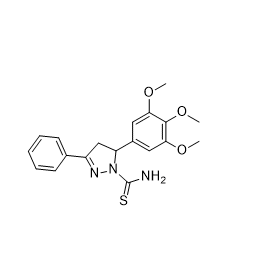| Cas No.: | 1370046-40-4 |
| Chemical Name: | 4,5-Dihydro-3-phenyl-5-(3,4,5-trimethoxyphenyl)-1H-pyrazole-1-carbothioamide |
| Synonyms: | SSE15206; SSE-15206; SSE 15206,1370046-40-4 |
| SMILES: | S=C(N1N=C(C2=CC=CC=C2)CC1C3=CC(OC)=C(OC)C(OC)=C3)N |
| Formula: | C19H21N3O3S |
| M.Wt: | 371.45 |
| Purity: | >98% |
| Sotrage: | 2 years -20°C Powder, 2 weeks 4°C in DMSO, 6 months -80°C in DMSO |
| Description: | SSE15206 is a microtubule polymerization inhibitor, with a GI50 of 197 nM in a SRB proliferation assay in HCT116 cells. |
| Target: | GI50: 197 nM (microtubule)[1]. |
| In Vitro: | Treatment of cells with SSE15206 result in rounding up of cells which prompt us to look for induction of mitotic arrest using phosphorylation of histone H3 (S10) and MPM2 as mitotic markers. Similarly, treatment with SSE15206 for 8 and 24 hours increase mitotic index compared to the DMSO control. The increase in the mitotic index is quantified and found to be statistically significant at both concentrations and time points. Activation of mitotic kinases, Aurora A, Aurora B and MPS1 in A549 cells accompanied mitotic arrest following SSE15206 treatment. Treatment with 1.25 μM and 2.5 μM concentrations of SSE15206 result in the failure of microtubules to repolymerize at 37 °C following incubation on ice, similar to the positive control nocodazole[1]. |
| References: | [1]. Manzoor S, et al. Identification and characterization of SSE15206, a microtubule depolymerizing agent that overcomes multidrug resistance. Sci Rep. 2018 Feb 19;8(1):3305. |

 DC Chemicals' products qualify for U.S. tariff exemptions. We guarantee no price increases due to customs duties and maintain stable supply, continuing to deliver reliable research solutions to our American clients.
DC Chemicals' products qualify for U.S. tariff exemptions. We guarantee no price increases due to customs duties and maintain stable supply, continuing to deliver reliable research solutions to our American clients.





















